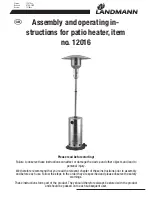
16
Installation of Vent Pipe
1. Remove the Top Filler and adapter plate from the unit by removing the five [5] screws as shown below. (Fig. 3) Attach
the vent pipes to the termination with Millpac and 4 screws per pipe joint. Be sure to label the exhaust and intake flex
pipes. Make sure not to connect the exhaust to the intake or vice-versa. Lower the termination and vent pipe down the
vent and screw and seal plate to the chimney crown, clay tile chimney or wood stove vent. It may be necessary to pre-
drill holes into the chimney crown (depending on material) (8 screws).
2. The two vent pipes should now be hanging in the existing fireplace. Attach the adapter to the two suspended vent
pipes with Millpac and screws. Let the adapter hang in place until the unit is ready to be positioned.
3. Slide the unit into place carefully. Ensure that the adapter slides along the top of the unit, in between the guides, and
check that it remains flat. (Fig. 2)
4. Once the unit is slid back into position use the two screws previously removed to secure the adapter plate. When
tightening the adapter plate check to make sure the plate is flat to the unit and the rear catch lock is engaged over the
rear tab of unit. (Fig. 2 & 3)
5. For CV models only: Reattach the Top Filler (Fig. 1A) with three [3] screws before installing the I33CV/I36CV Fronts.
6. When using the I33LK/I36LK unit discard the Top Filler Panel and attach the I33LK/I36LK Front as per the instructions
shown in the I33LK/I36LK Front Face Attachment Installation section.
7. Use Millpac to seal the vent pipe joints and ensure that it is free of any leakage.
NOTE: If the factory-built fireplace has no gas access hole(s) provided,
an access hole of 1.5in [37.5mm] or less may be drilled through the
lower sides or bottom of the firebox in a proper workmanship like
manner. This access hole must be plugged with non-combustible
insulation after the gas supply line has been installed.
















































